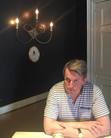Gully Foyle: The Best Science-Fiction Comic You Never Read - Part 2
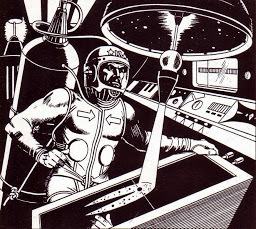 The following is the second (and final) part of my revised and updated account the "Gully Foyle" comic-strip saga, which I originally wrote for the long-expired PulpFaction.net website back in 2007. You can read the preceding installment by clicking here. You may also want to read Daniel Best's comparable account of Reg and Stan Pitt's "lost" comic strip masterpiece at his 20thCentury Danny Boy blog.
The following is the second (and final) part of my revised and updated account the "Gully Foyle" comic-strip saga, which I originally wrote for the long-expired PulpFaction.net website back in 2007. You can read the preceding installment by clicking here. You may also want to read Daniel Best's comparable account of Reg and Stan Pitt's "lost" comic strip masterpiece at his 20thCentury Danny Boy blog.Readers are also encouraged to visit the Stan and Reg Pitt Facebook Group, to view and share rare artwork and photographs devoted to these artists' lives and work.
The Birth of Gully Foyle
Many aspiring cartoonists who began their careers drawing comic books in the 1930s and 1940s hoped they could leverage their experience to break into the competitive, and highly lucrative field of syndicated newspaper comic strips. Stan and Reg Pitt harboured similar ambitions, especially as they had already tasted some measure of success with Silver Starr in the Flameworld for the Sunday Sun and Guardian newspaper. They had developed a daily newspaper comic strip based on Lemmy Caution, the FBI agent created by the British author, Peter Cheyney (1896-1951), which apparently caught the interest of overseas publishers. But the project was abandoned when it became apparent that the promised syndication revenues would not cover the royalty payments demanded by Cheyney’s literary estate (See image below).
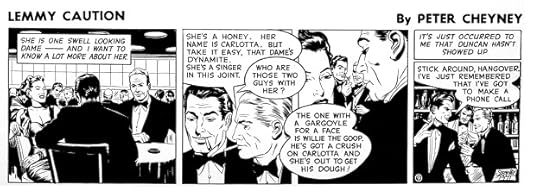
Undeterred, Reg Pitt became convinced that The Stars My Destination would be the perfect vehicle to help them realise their shared ambitions.
‘The book made an indelible impression on me for so many years – even though it would be 10 years before we finally got the chance to do it,’ says Reg. ‘It became an obsession with me over all that time,’ he admits freely. ‘It became an absolute necessity for us to do something with it.’
Stan Pitt, too, could see the visual potential of Bester’s groundbreaking novel.
‘Reg put it to me one morning that I should think about doing another comic, a science-fiction comic, this time by a well-known American author,’ he recalls. ‘He told me that this [book] was the best thing that had ever been written in science-fiction, from the point of view of illustration. He said, “It’s just made for you and if you do it…we’ll have no trouble selling it to America”.’
Reg set about contacting Alfred Bester through a Sydney solicitor known to his family. ‘He was a real cricket nut, because every time we said “Bester”, he kept referring to him as “Bedser” – after the English cricket captain [Alec Bedser]!’
While their solicitor set the legal wheels in motion, Reg and Stan busied themselves preparing a presentation folder showcasing their vision for how their new comic strip – titled Gully Foyle, after the novel’s protagonist – would look.
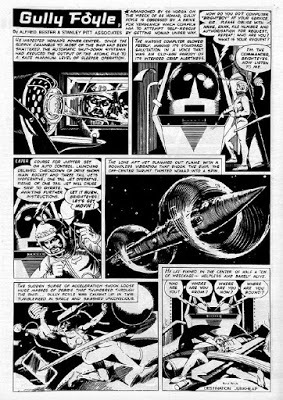 ‘Stan drew illustrations of all the main characters, and depicted situations in which they would find themselves in the comic strip,’ according to Reg. ‘I recall one of those images specifically showing the “burning man” who appeared throughout the book.’
‘Stan drew illustrations of all the main characters, and depicted situations in which they would find themselves in the comic strip,’ according to Reg. ‘I recall one of those images specifically showing the “burning man” who appeared throughout the book.’ The brothers prepared high-quality bromides (black & white photo-prints) of the sample art pages, which Stan hand-tinted using coloured inks.
‘We put these pages together in a presentation folder, which we put inside this graphically designed box, using coloured paper inside and out,’ says Reg. ‘I made all the stuff to go with it – we had to make it so appealing that he [Bester] couldn’t resist it.’
Reg wrote a cover letter to accompany the parcel – then sat back and waited for a response. And waited.
‘There was a period of months where nothing happened,” explains Reg. ‘Then we got this telegram from Alfred Bester and it was obvious he was really annoyed.’
‘The impression we got was that US Customs had told him that the parcel we sent him had insufficient postage and that he’d have to pay for it, if he wanted to get it.’
‘It turned out to be some puny amount, less than US$30 – but our package of artwork was worth hundreds of dollars and I thought, “What a bloody hide you’ve got”!’
The postal delays were overcome, but getting the green light from Alfred Bester to proceed with the comic strip was by no means easy.
‘Alfred Bester was a strange guy,’ explains Reg. ‘He used to send us these pages from notepads, with little notes scribbled on them.’
‘They reminded me of that line from [Australian poet] A.B. “Banjo” Paterson – “like a thumbnail dipped in tar” – these strange notes scribbled in thick pen. He seemed all the time to be preoccupied and these [notes] looked like afterthoughts.’
‘From what we could glean, he gave us carte blanche to do what we wanted. He said. “You obviously know what you’re doing” – he didn’t even make any monetary demands.’
The sporadic correspondence between Reg and Stan Pitt and Alfred Bester was no doubt partly caused by Bester’s nomadic working life. By the late 1950s, Bester was firmly established as the literary editor of Holiday magazine, a role which frequently saw him travel abroad (You can read one of Bester’s articles for Holiday, published in 1961, by clicking here).
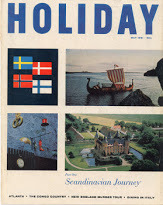
As a result, months passed, and eventually dragged on into years, before the Pitt brothers began work on Gully Foylein earnest.
The project almost ended before it began, when Reg was seriously injured in a car accident, while travelling home in a taxi one night. While recovering from his injuries, Reg received a compensation payout which gave him and Stan the funds they needed to work full-time on the Gully Foyle comic strip.
‘We got enough money to carry us through,” explains Reg. ‘We took out an office in [the Sydney suburb of] Burwood, just to work on the comic – we paid the rent on that and we could draw wages for both of us.’
‘We started work on the strip in 1963, because that’s when my daughter [Jasmine] was born,’ Reg explains, ‘because I had great plans for her future – that would’ve been the motivation to launch the comic.’
In recognition of what he called Bester’s “pyrotechnic” style, Reg decided that he and Stan would abandon the traditional weekend newspaper comic-strip format. Not only would Reg consciously retain much of Bester’s original text for the script, but he and Stan decided to present the strip as a full-page feature.
Although Reg was known to Australian comic book readers primarily as a writer, his collaboration with Stan was a true artistic partnership.
‘My main talent was always art and I was working in the advertising industry all this time as a graphic designer,’ he explains.
‘The writing [for comics] was something I’d been doing all my life, working on comics with Stan since I was 10 years-old.’
‘Stan and I would have brainstorm sessions about the characters and ideas,’ he adds. ‘For instance, we changed Gully Foyle’s helmet from our original, Ned Kelly-styled helmet, to a more modernised design.’
Some aspects of the book were changed, such as the extended sequence where Gully Foyle manually fires the Nomad spaceship’s rockets, which Reg replaced with the introduction of an intelligent, onboard computer, which sent the Nomad spinning off into space at Foyle’s insistent command. (“Let it burn, Brighteyes! Let’s get movin’!”)
‘I’d do the backgrounds on Gully Foyle,’ explains Reg. ‘When it came to designs that would entail buildings or structures, I’d do those, as Stan would much rather draw [human] figures.’
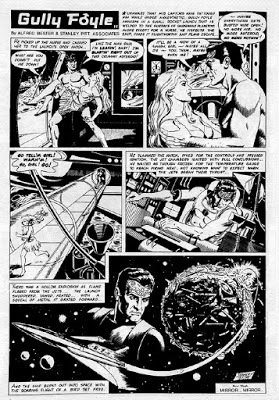
The Pitt brothers worked devotedly on the comic strip for months on end, as they compiled 14 weekly episodes, so they would have a backlog of work ready to publish, if the strip was eventually picked up by a newspaper syndicate. The comic strip sequence concluded at the point where Gully Foyle blasted off from the Sargasso planetoid aboard a stolen spacecraft.
‘We were going after the [American] Sunday papers, but we’d come into a lot of problems, with the [full-page] layout of the comic,’ according to Reg.
‘The Americans wanted a [half-page] landscape format in Sunday strips, so we went through [preparing] several versions of the strip in landscape format.’
‘We even had to put in two “drop-out” panels, which could be taken out, without affecting the story, as well as reduce the size of the artwork,’ he explains.
‘There were two versions of [Gully Foyle] in the alternate landscape format that have never been published – they’ve never even been looked at.’
The Fan Ambassador
Their efforts to sell Gully Foylereceived some unexpected support from a local comics’ fan, John Ryan (1931–1979), who not only published Australia’s first comic fanzine, Down Under (1964), but was also a prolific contributor to American comic fanzines and amateur press association (APA) publications. Ryan won an Alley Award (named after the comic strip character Alley Oop) for Best Article (Fan Category) in 1965 for his piece, “Down Under with the Comics”.
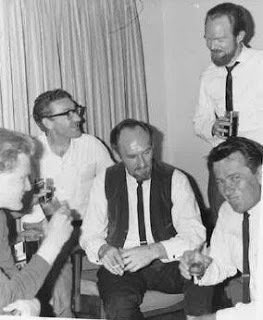 The adjacent photo shows from left: (Unidentified); John Ryan (wearing spectacles); Stan Pitt (wearing vest); Reg Pitt (with beard); and Paul Wheelahan, circa mid/late 1960s.
The adjacent photo shows from left: (Unidentified); John Ryan (wearing spectacles); Stan Pitt (wearing vest); Reg Pitt (with beard); and Paul Wheelahan, circa mid/late 1960s.Ryan devoted an entire installment of his “Bidgee” column to the Gully Foyle project, which appeared in the June 1967 edition of the American fanzine, Star Studded Comics. This provided American readers with their first glimpse of Reg and Stan’s breathtaking artwork.
‘I designed the logo for John’s “Bidgee” column,’ Reg explains. ‘He was only too happy to promote it – he was delighted we were doing a new comic and were aiming so high for it. He was a good friend in that regard.’
Ryan was so passionate about Gully Foyle that he even acted as a go-between for the American newspaper syndicates and the Pitt brothers.
‘John handled all the correspondence on our behalf, and we received replies from most of [the newspaper syndicates] – and some of them were very favourable,’ according to Reg.
‘There was a publisher in New York that was very interested in it,’ as Stan Pitt recalled, ‘and it reached the point where it would have appeared in a few weeks in 25 newspapers throughout the United States.’
‘But they wanted confirmation [from] Alfred Bester himself that it was okay for them to go ahead and do it,’ added Stan.
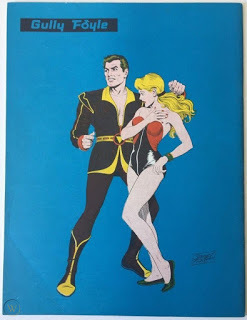 ‘John Ryan carried out a lot of correspondence with the publisher to try and get Alfred Bester to answer his letters, but he never did,’ explains Stan. ‘When Reg finally got an answer from [Bester] to his letters, he [apologized], but when those letters arrived, [Bester] was away on an assignment in Paraguay for Holiday magazine.’
‘John Ryan carried out a lot of correspondence with the publisher to try and get Alfred Bester to answer his letters, but he never did,’ explains Stan. ‘When Reg finally got an answer from [Bester] to his letters, he [apologized], but when those letters arrived, [Bester] was away on an assignment in Paraguay for Holiday magazine.’ The adjacent image shows the back cover of Star Studded Comics no.11 (Summer 1967), the American comics fanzine featuring John Ryan's "Bidgee" column devoted to Stan & Reg Pitt's then-unpublished Gully Foyle comic strip.
Despite receiving Bester’s initial blessings to proceed with the comic strip, an unexpected legal obstacle arose when it was discovered that a planned film adaptation of The Stars My Destinationapparently included exclusive rights to any comic strip adaptation – which meant that Reg and Stan Pitt no longer held the licensing rights to create and sell the Gully Foyle comic strip.
The tyranny of distance, especially in those years before the advent of fax machines or email, also worked against the Pitt brothers.
‘What it amounted to in the end,’ explains Reg. ‘As someone said to us, “if you could be across my desk, we could solve a lot of problems there and then”. The distance [between Australia and America] was what went against us in the end.’
Eventually Reg and Stan decided to abandon the project and concentrate on their respective careers, with Reg returning to the advertising industry, while Stan cemented his position as the premiere cover artist for Cleveland Publishing’s flourishing line of Western :pulp" novels. (Stan eventually painted over 3,500 covers for Cleveland Publishing during 1958-1986. Shown here is Stan's cover for "The Dark Amen", Top Hand Western No.269, Cleveland Publishing, circa late 1960s.)
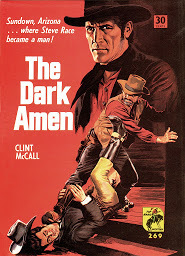
‘By 1967, we were both entrenched in our jobs and gave away all our foolish expectations,’ says Reg. ‘It was a shame, because I recognised Stan’s brilliance as an artist, and Gully Foyle was my futile attempt to wring out one last great comic strip from him.’
The Resurrection of Gully Foyle
Nevertheless, their “failed” project opened doors for Stan and Reg Pitt. Copies of the promotional Gully Foylebooklet compiled by John Ryan caused quite a stir among American comics circles. Acclaimed comic artist Al Williamson was a big fan of Stan’s work on Silver Starr and showed copies of the Gully Foyle samplerto Carmine Infantino and Dick Giordano at DC Comics, who were clearly impressed by Stan and Reg’s work. Consequently, Stan and Reg were commissioned to draw two stories for DC Comics’ horror title, The Witching Hour (Nos.14 & 38). They also produced stories for Gold Key’s mystery anthologies, including The Twilight Zone (No.48) and Boris Karloff Tales of Mystery (No.33). Stan also worked as the uncredited “ghost artist” on the syndicated newspaper comic strip, Secret Agent Corrigan, substituting for the series’ regular illustrator, Al Williamson, for brief periods in 1969 and 1972 (Shown below are two daily episodes of Secret Agent Corrigan, drawn by Stan Pitt, dating from 18-19 August, 1969).
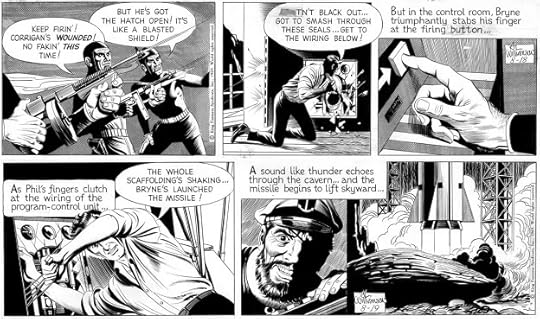
In 1975, Marvel Comics' black & white magazine, Unknown Worlds of Science Fiction, published an interview with Alfred Bester in its second issue, which reproduced a page from Stan & Reg Pitt's comic strip. Gully Foyle, however, seemed destined to languish forever unseen, until decades later, when an Australian advertising artist and comics’ publisher, Richard Rae, introduced himself to Stan Pitt.
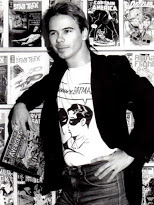 Richard Rae, 1984
Richard Rae, 1984During the late 1970s and early 1980s, Rae had been actively involved in different aspects of Australia’s still largely moribund comics’ scene. Briefly working as a cover artist for Sydney publisher KG Murray’s line of American reprint comics, Rae began writing and publishing a series of science-fiction comics, including Star Heroes and The Greatest Super Hero.
He co-owned and operated Sydney’s Comic Empire store with the late Peter Mitris, who disappeared under mysterious circumstances in 1991. Rae was the principal organiser behind Australia’s First International Comic Convention, the grandly named event held at the Sydney Opera House in January 1986, which featured American comic book artists Will Eisnerand Jim Steranko as headline international guests (Stan Lee, publisher of Marvel Comics, was slated to appear as Guest of Honour, but withdrew from the event at the last minute).
It was during this period that Richard Rae first met Stanley Pitt. ‘My first contact with Stan was when I was putting together my Cartoonists of Australia book back in the early ‘80s,’ he recalls (See cover image below).
‘Stan did not have the time to be interviewed for the book, as he was flat-out doing paintings of western covers [for Cleveland Publishing].’
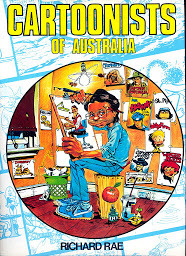
‘Also, he was not that interested in being in my book, as John Ryan’s history of Australian comics, Panel by Panel[which prominently featured Stan’s work] had just been released in ‘79.”
‘Later, when Stan and I actually met for the first time, Stan told me he had made a mistake not being in the book, as it was one of his favourite books, because it included photos of all the artists - something I've always insisted upon and that Panel by Panel did not have.’
‘Anyway, we just hit it off great and my family became really good friends with him – my son even called him “Poppa Stan”.’
‘Then, during one of our weekends together, Stan and Reg told me the full story about Ryan and Bester and Gully Foyle,’ Richard says. ‘Stan was really sad that no one wanted to run with it … not Marvel Comics, not DC, not King Features Syndicate … no one!’
‘It was that same weekend Stan asked me to be his manager,’ explains Richard. ‘As Stan was always being bugged by fans and collectors who wanted a piece of him, so I said, “Let’s let them have a piece of you – but let’s make sure you get paid for that piece”.’
‘Stan loved that idea, so I went about producing a number of items that Stan and I could sell to fans and collectors.’
Under the banner of his new company, Home Grown Media, Rae repackaged and marketed a range of publications and ancillary items, featuring examples of Stan’s “pulp fiction” cover illustrations on posters and calendars (see image below), as well as giant-sized reproductions of the early Silver Starr in the Flameworld comic strips.
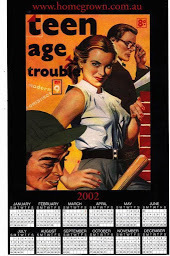
Perhaps the most sought-after title amongst all these was the limited-edition Gully Foyle magazine released in 2001, which published for the first time in Australia all 14 full-page instalments of the Gully Foyle comic strip.
‘The “compleat” Gully Foyle book was just one of the items I produced,’ Richard explains. ‘But Stan and Reg were blown away [to see that] their amazing work on Bester’s story was finally in print!’
The End
The author would like to thank the following people, whose gracious assistance and generosity of time made this article possible: Graeme Cliffe; Dr. Jasmine Henderson; Luke Pitt; Reg Pitt; Richard Rae; Dennis Ray; and John Weeks. All errors and omissions, however, are the author’s own.
Text © copyright 2007-2020 Kevin Patrick and cannot be reproduced without the author’s permission, except for purposes of comment and review. All featured artwork and/or images are © copyright 2007-2020 their respective copyright holders and are reproduced here for the purpose of comment and criticism.
All quotes attributed to Stanley Pitt are taken from a transcript of a radio interview (© Spectrum FM Radio) conducted by John Weeks on 1 November 1997 on 3MDR 97.1 FM, Victoria, Australia, and used with permission.

